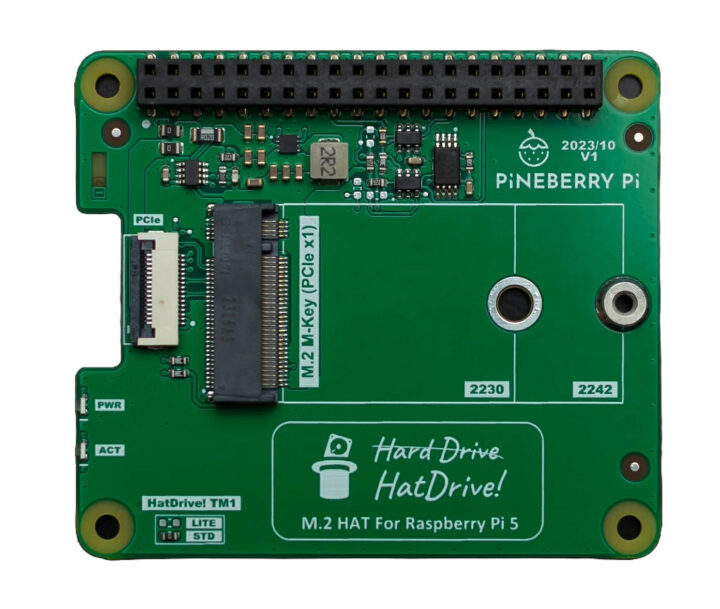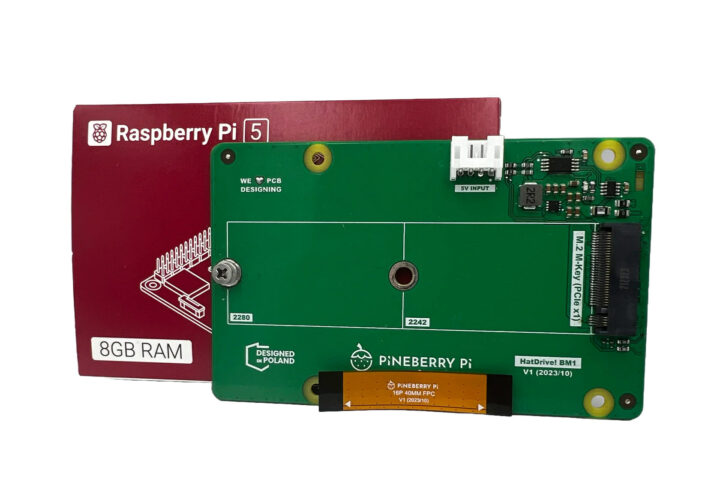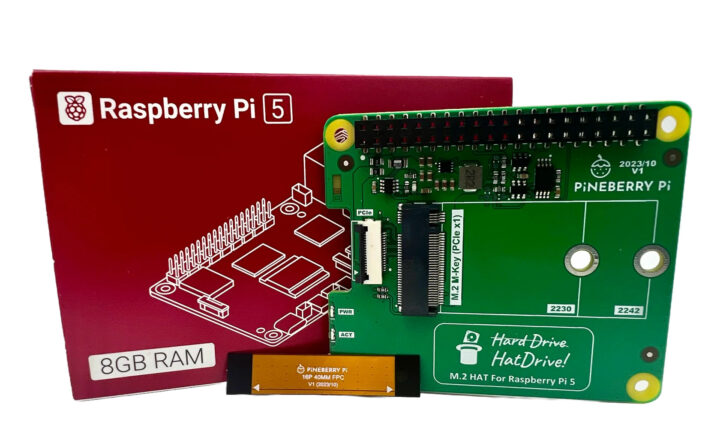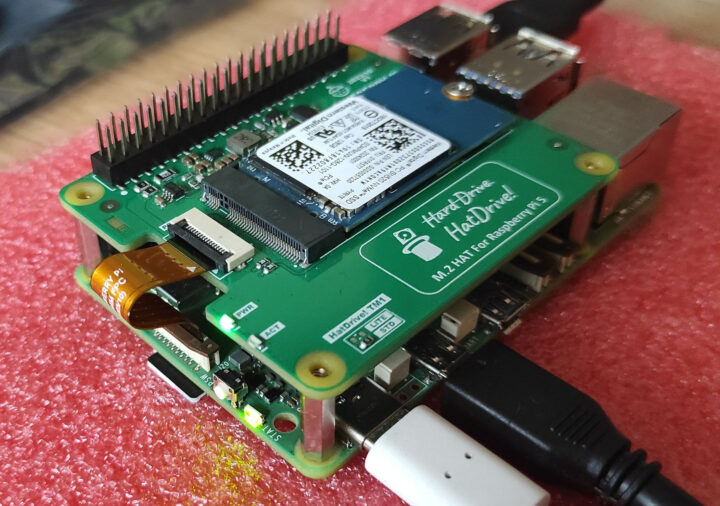The Raspberry Pi 5 SBC comes with a PCIe 2.1 x1 interface that has not been overly useful so far since it’s exposed through a non-standard FPC connector. Raspberry Pi Ltd is working on its own HATs to make use of the PCIe connector, but PineBerry Pi may have beaten them to it with the launch of the HatDrive M.2 HAT for Raspberry Pi 5.
The HatDrive comes with an M.2 Key-M socket with a PCIe x1 interface and support for 2230 and 2242 modules, so you can install an SSD, an AI accelerator, or another compatible M.2 module. The HAT is connected through a 40mm long 16-pin FPC cable (that supports up to PCIe Gen3) as well as the 40-pin Raspberry Pi GPIO header for the I2C EEPROM required by compliant HATs, plus power supply monitoring and diagnostics, and to let users add another HAT on top if needed. It also comes with spacer pins, M2.5 screws, a spacer pin for M.2 card mounting, and an optional male-female HAT connector.
 The PineBerry Pi HatDrive specifications also add a few more details:
The PineBerry Pi HatDrive specifications also add a few more details:
- Voltage regulator delivering up to 3A for the 3.3V power rail, compliant with M.2 (NGFF) standard.
- Installation of M.2 disks in 2230 or 2242 format thanks to a dedicated metal bracket (custom CNC made).
- Misc – 2 LED lights for power supply voltage (“PWR”) and M.2 disk activity (“ACT”).
- Power Supply
- Via FPC PCIe ribbon (port providing a minimum of 5W continuous power) or
- Via 40-pin HAT connector
- Monitoring – Monitoring and diagnostics of the power supply bus, measuring voltage, current, and power parameters in real time via an I2C interface
- Dimensions – 65 x 56.50 mm (4-layer PCB, Raspberry Pi HAT compliant)
The Polish company will soon manufacture 5,000 pieces and is taking pre-orders for the HatDrive for 20 Euros “including taxes” with shipping scheduled to start in early December.

As I was about to complete this post, I also noticed PineBerry offers the “HatDrive! Bottom” that’s not quite an HAT since it is bigger (90 x 56 mm) and is meant to be connected on the bottom side of the Raspberry Pi 5, but have the advantage of supporting M.2 2230, 2242, and 2280 NVMe SSDs. The rest is pretty similar to the HatDrive HAT, except there’s an extra through 5V 4-pin connector acting as a redundant power supply (up to 2A at 5V). It can be pre-ordered for 25.99 Euros.

Jean-Luc started CNX Software in 2010 as a part-time endeavor, before quitting his job as a software engineering manager, and starting to write daily news, and reviews full time later in 2011.
Support CNX Software! Donate via cryptocurrencies, become a Patron on Patreon, or purchase goods on Amazon or Aliexpress







The more you think about RPi 5, the more absurd it is. 500 MB/s here we come.
> 500 MB/s here we come.
Less since if you assume you’re limited to PCIe Gen2 then 8b10b coding is in the way and lowers througput by a margin. When switching to Gen3 you’re getting closer to 900MB/s: https://www.jeffgeerling.com/blog/2023/testing-pcie-on-raspberry-pi-5
And as always: sequential transfer speeds are way overrated with majority of use cases on such a board. Random I/O almost always matters more and here the differences between e.g. Gen3 x4 and Gen2 x1 should be negligible (or at least not able to notice)
As much as I think the Pi5 is a bad joke, even a single lane PCI-E v2 M.2 connector is better than all previous SBC storage interconnects. The latency is lower, the protocol is more robust, and it can be repurposed to other interconnect tasks if necessary.
Is this a subsidiary of Pine64’s EU branch?
It’s what happens when Raspberry Pi meets Pine64…
In which way? At least I don’t see Lukasz being involved at all?
Actually Pineberries are a fruit variety 🙂
I was being facetious… 😉
No, this is fresh company, founded just few days ago, but one of founders was earlier known because of pi4cm carrier board (Mirko Electronics). You have some info in about us tab 🙂
Is it compatible (in term of space) with the active cooler? All the hats now will cover the fun.It could be a problem?
Those two hats looks awesome, but they are certainly not €20. Just tried to order bottom version, its priced as €26 + shipping + tax. Shipping to Poland (where its designed and manufactured) is €10 and final price with taxes is almost €45. Wow, this is really expensive m.2 port that raspberry foundation should already include in this SBC.
Some adapters were needed to several other boards for their m.2 slots, basically to place nvme comfortable location. Radxa sells their extension boards on allnet for $10 (both Rock4 variant as well as Rock3/5). Also khadas has something similar for vim3, as far as I remeber m2x was priced for $8. On both cases you could use m.2 slot without anything else and with small 2230 nvme it looked like big sd card. On pi5 pcie link port is useless without dedicated accessory and this one cost almost the same as whole board 😉
Jeff Geerling has a sample and he ran PiBenchmarks with PCIe Gen3
https://twitter.com/Mirko_DIY/status/1725411229320015922
HDParam reports around 777MB/s for sequential reads.
It’s both sad and strange that people still use hdparm as ‘benchmark’ in this century. I dropped Jeff a note: https://github.com/geerlingguy/raspberry-pi-pcie-devices/issues/559#issuecomment-1816485865
While I don’t always agree with you we definitely see eye to eye on using hdparm for testing transfer speed.
I was about to post a rant about the 2230/2242 form factor when I saw the “oh and also” part about the underneath board. That one has a proper length slot *and* doesn’t get in the way of the absolutely necessary active heatsink.
I wish it had gone the extra mile to adding a proper power input for the Pi5. (sadly, I can’t expect it to fix the poor choice of video outputs)
What about the cooling fan in the case for the heatsink?
I just bought a “5” with fan case and heatsinks…
Don’t think that’s going to work with a SSD hat on top!!
Any ideas??
We got one for testing with a RPi5, but while all the lights turn on with the hat, the drive (which is on the list of compatible drives) does not get recognized in lsblk. We did the configurations on /boot/config.txt that were listed in the documentation for non-boot-to-nvme, but it’s still not showing up. Anyone have any ideas?
There may be issues with WD SN530 drives even though they are shown as compatible in the docs.
Pineberry mentioned that a few days ago on Twitter:
We figured out the problem. We were using Ubuntu 22.04.3 for Pi, and it just didn’t have the proper stuff to enable the PCIe. When we switched to the pure Raspbian OS, it worked. Any idea if there will be collaboration with Canonical to get the proper drivers into Ubuntu?
Good to know. I understand Ubuntu officially supports Raspberry Pi, but right now, they only list Ubuntu 23.10 as being supported for the Raspberry Pi 5, although not certified yet.
> Ubuntu 22.04.3 for Pi, and it just didn’t have the proper stuff to enable the PCIe
And this statement is in which way related to the former recommendation to ‘stay away from WD drives entirely’?